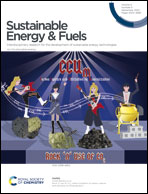Converting micro-sized kerf-loss silicon waste to high-performance hollow-structured silicon/carbon composite anodes for lithium-ion batteries†
Abstract
Low-cost feedstocks and rationally designed structures are the keys to determining the lithium-storage performance and practical applications of Si-based anodes for lithium-ion batteries (LIBs). Herein, we employ low-cost micro-sized kerf-loss silicon (KL-Si) as the cheap feedstock and melamine resin as the carbon source to prepare a hollow-structured Si@void@C composite. The naturally formed SiOx film and the organic layer on the surface of KL-Si during the diamond wire slicing process serve as a natural sacrificial double template to create voids between the Si core and a melamine resin-derived carbon coating. The as-prepared hollow-structured Si@void@C composite anode delivers 1164.4 mA h g−1 at 1 A g−1 after 300 cycles with a retained capacity of 927 mA h g−1 after 500 cycles at 3 A g−1. The full cell with the prelithiated Si@void@C anode and a Li(Ni0.6Co0.2Mn0.2)O2 cathode boasts a high a capacity retention of 81.5% after 150 cycles. This paper presents a straightforward approach to converting low-cost KL-Si waste to value-added LIB anodes, enabling the full utilization of the Si feedstock in the photovoltaic industry.



 Please wait while we load your content...
Please wait while we load your content...